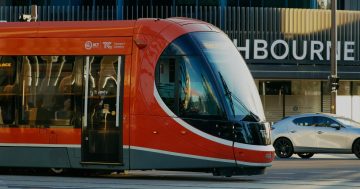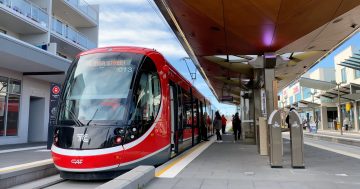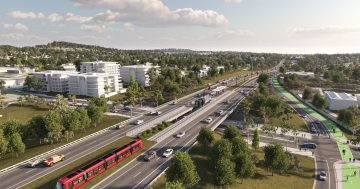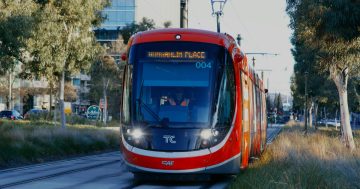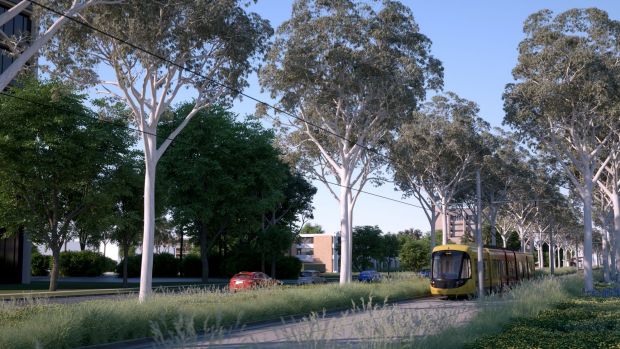
Since 2012 we have seen almost every action and decision of the ACT Government linked to light rail by opponents of better public transport. They see light rail behind every government decision and spending announcement. It’s a deceptive, shallow and misleading campaign that the public is tired of.
My intention in stepping through the economic arguments in this article is to assure you that the big numbers are not scary numbers, that the Territory is in a position to afford light rail, that you are paying for light rail in the same way as you pay for any other public service provided by the government, and that your rates are not increasing to pay for light rail.
Neglecting road and public transport in Gungahlin 20 years ago has had negative impacts on Canberra today. Northbourne Avenue is still Canberra’s most congested road, despite Majura Parkway and the GDE being built.
Stage One of Canberra’s light rail network is now underway. The long suffering residents of Gungahlin and north Canberra that endure road congestion and jam-packed ACTION buses can travel past light rail construction and know that a better alternative to driving and parking every day, or riding in sardine packed bus (if it doesn’t drive past them already full), is on schedule to commence in 2018.
Despite this overwhelmingly obvious need for improved public transport, the community has been subjected to increasingly shrill and unbalanced arguments from opponents of public transport. Many of the arguments against light rail are focussed on the economics.
The economic claims fall into several broad categories: that the costs don’t ‘stack up’, light rail is unaffordable, the money could be spent elsewhere (with health and education the key areas), and too much money is being spent in Gungahlin to benefit too few people. Then there is the claim that rates are rising to pay for light rail.
Let’s examine these various claims one by one.
The ACT Budget papers for 2016/2017 show that health, education and disability services are 56% of the total budget, and public transport only 4%. Light rail was allocated 0.4% of the budget, to pay for the Capital Metro Agency. A contract for the construction and operation of light rail stage one was signed in 2016. We now know that the cost of light rail will be $65 million a year for 20 years.
The $65 million a year cost for light rail does ‘stack up’. Public transport is a service delivered by the government in the same way as it delivers health services, educates our children and collects our rubbish. We pay for all these services, even if we don’t use them.
We don’t ask students to pay for their education (although their parents can choose private schools), we don’t ask those who can’t pay for money before medical treatment (although they can privately insure or use private medical facilities), and we don’t charge the blind or the elderly the full cost of a bus ride.
The reason we don’t do this is that there are public expectations that the money used by the government on our behalf will be expended equitably. In areas that may never benefit us directly. As Canberra expands and grows to half a million residents, we need to provide support for that growth and manage it so it doesn’t negatively impact us directly or indirectly. Public transport is no different, and light rail is no different.
Why is it important that the costs ‘stack up’? If we want public transport to be profitable, we need to insist the government charge the full cost of every trip to every bus passenger, and dramatically reduce the salaries the ACTION workforce enjoys. It is unlikely that either side of politics would adopt this view.
The real question is – what are the costs of not having public transport? The community accept that public transport needs to be provided as it benefits all sectors of society and the cost of not providing public transport would lead to massive road congestion. Those buses that take your children to school, or ferry you from Floriade and Raiders games, would still need to be provided for in some way.
Privatising ACTION would not bring about any budget joy as the public would still have expectations such as subsidised school fares, concessions for pensioners and health care card holders.
Political realities would dictate government subsidies to private operators to perform services in areas where the private operator would not be able to profitably operate a route.
Because we demand certain concessions for different sectors of society, public transport may never be profitable. Is this wrong? The cost of public transport is the same as any other service that we expect the government to deliver. This is the reality of all public transport services across Australia.
The main focus should be on delivering public transport in the most efficient way, in cost and service delivery.
The fare box of ACTION Buses provides only 20% of its funding, and that amount has been declining as patronage declines. If we want that revenue to increase, it needs to come from full fare paying adult passengers that commute every day. Light rail is a proven way to increase public transport patronage. This has been recently demonstrated by Gold Coast light rail.
Light rail is proven to attract and increase public transport patronage, and is cheaper to operate over the longer term than buses. When a truly integrated public transport system exists, public transport use rises and road congestion decreases. In Canberra, public transport use has decreased and road congestion increased. Buses alone cannot serve our current or future public transport needs.
The other claim of the anti public transport forces is that light rail is unaffordable. They quote the total project cost of $930 million and fulminate about this cost. They invent a fictional cost of $1.8 billion.
They don’t tell you that this will be paid over 20 years. That the actual cost to the ACT is $65 million a year, for twenty years. That this is how most infrastructure assets are paid for. They realise this figure is affordable, and pretend it doesn’t exist.
Paying for light rail over twenty years is the same way that we all pay for a home when we seek a mortgage. Few of us are in the position of paying for a home from the money we earn this year. It is the sensible way to acquire any asset.
Where is this money coming from then?
The majority of the money to pay for light rail will come from selling assets such as ACTTAB and old public housing stock. These assets aren’t leaving the ACT; they have transferred ownership and the money is being reinvested in the ACT.
New public housing of better quality is being built to house the tenants that are relocating, and this is part of a long-term program to improve public housing stock. No tenant will be homeless as a result, and they will certainly be rehoused in better quality housing than the rundown housing along Northbourne Avenue.
Recycling these assets is a very successful way to fund new public transport infrastructure, spark urban renewal along a tired corridor and rehouse public tenants in better quality housing. The benefits transcend public transport and benefit several areas of our economy such as employment and construction.
The asset recycling program has already raised $400 million of the expected $930 million before the first payment to the Canberra Metro consortium is required (in 2018, the first year of light rail operations). The Federal Liberal government has also contributed $66 million towards this project, as it is seen as a way to boost productivity.
The rest of the money for light rail will come from the ACT Government via General Government Service revenue, which totals around $5.1 billion in 2016/17. Commonwealth Grants are over 40% of this $5.1 billion, our rates less than 20% at $447 million. Interestingly, the amount received from payroll tax was almost identical to the amount received from rates, yet I have never heard anyone complain that payroll tax is increasing to pay for light rail.
If we can’t pay for $65 million a year for 20 years out of $5.1 billion dollars a year (in 2016 terms), we are in bigger trouble than cancelling light rail will solve. It is a small one percent of our annual budget that is entirely manageable and a sound investment in our future. Most people’s car payments are greater than 1 percent of their annual income.
The selfish argument that light rail will only benefit a small percentage of the population is also false. Gungahlin’s population will be at 100,000 within ten years. Based on ABS statistics from the 2011 census, the corridor for light rail Stage One that takes in much of North Canberra has 9% of Canberra’s population within one kilometre of the light rail line.
That doesn’t take into account the population of Woden or the Inner South of Canberra that would benefit from the Stage Two extension. That doesn’t take into account the people that would catch one of the more frequent integrated bus services to a light rail station. That doesn’t take into account those that will use the free ‘Park and Ride’ instead of paying around ten dollars a day to park their car in Civic or the Parliamentary Triangle.
It is also selfish and disingenuous to object to public funds being spent in areas that don’t directly benefit the individual. You may never need to use a sewage pipe in Theodore, but the greater public of Canberra benefit from a sewerage system. Public transport and road infrastructure are exactly the same.
Public infrastructure is for the general use and benefit of us all. Schools and hospitals are expensive to construct and staff, but no one objects to publicly funded health service or schools, even if we haven’t used them in years. They may be used by friends or loved ones, or ourselves at some point in the future.
No one uses every road in the ACT. However we all contribute to the funding and construction of these roads. People in Canberra’s north may never use the Monaro Highway, but they appreciate and understand how these roads benefit people in other areas of Canberra, including friends and family. Light rail stage one and stage two are no different.
Finally, let us look at your rates. The ACT Government went to the 2012 Assembly election with a range of taxation reform measures. It proposed removing stamp duty and inequitable taxes and slowly increasing rates. In the face of a concerted ‘your rates will triple’ campaign from the Canberra Liberals, the public returned the Government.
It was a courageous election policy, so courageous that Liberal Prime Minister Malcolm Turnbull has supported it, and described the political difficulty in securing this type of taxation reform as ‘ten out of ten’. It is a taxation reform that almost all economists recommend other states adopt; yet they lack the political will to attempt it.
Our taxation reform is designed to ensure a predictable income stream buffered from the stamp duty property boom and bust cycle. Stamp duty has been reduced; eventually it will be removed altogether. There have also been cuts to insurance taxes, car taxes and payroll taxes.
This provides a more predictable stream of income that prevents slashing services in years when stamp duty income suffers from a real estate ‘bust’ period. No one likes paying bills, and no one likes rates increasing, but they would also complain and be materially impacted if services had to be cut if the real estate market collapsed
The ‘triple your rates’ campaign run in 2012 is again being run by the Opposition, although as the tripling didn’t occur, they are now referring to rates increases as ‘unfair’. Yes our rates will steadily increase. Stamp duty elimination is only a part of that. Rates are also increasing as our home values increase.
Note that the fear campaign doesn’t have a promise of reversing taxation reform and reintroducing the inherently illogical stamp duty grab.
The real issue for this election campaign is this – are the increases in rates related to light rail?
The answer is no. Categorically they are not. As shown earlier, rates are less than 20% of our total budget. Light rail is not being paid for from your rates. To suggest that rates will increase to pay for light rail is a deceptive fear campaign not based on any evidence.
When light rail begins operation, the ACT Government will pay the private operator an annual fee to operate the light rail service and pay the balance of the construction cost. In twenty years, the consortium operating light rail on our behalf will hand the asset back to the ACT government, and we will have a workforce and administration with the experience to manage the network.
The annual payment to the Canberra Metro consortium will be $65 million or 1% of our current annual budget. In 2036 that $65 million will be a fraction of the annual budget of the ACT. Recall that the Commonwealth Grants totalled $5.1 billion dollars.
Funds used for major projects are usually raised through asset sales, Commonwealth Grants and borrowings. That is what is happening in the ACT. We aren’t paying for light rail from your rates, and they aren’t increasing to pay for light rail.
When you look at all slices of the budget pie, 1% is not much compared to 56%. There may be room for reform and productivity savings in the ACT Health and education sectors; and this would bring about far greater benefits on the front line of services than taking the 1% allocated for light rail and having to endure the future costs associated with road congestion and the drag on productivity that this would result in.
The case stacks up for light rail.
For more frequent updates on Capital Metro and light rail related news, please visit our Facebook page ‘Light Rail for Canberra‘.
This article was originally published on the ACT Light Rail website here.












